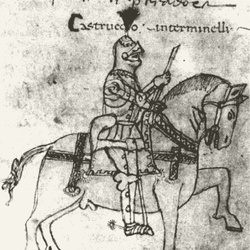Castruccio Castracani
Valle del Serchio. Più vicino a te

Castruccio Castracani was one of the most valiant condottieri in Italian history. Born in Lucca in 1281, he was a remarkable member of the Antelminelli family. When the Guelph Bonturo Dati came to power, Castruccio was exiled with his family as a supporter of the Ghibelline faction. He then moved to England and the court of King Edward 1, where he improved the use of arms and knowledge of the tactics of war.
Seizing the opportunity of the descent of the emperor Henry VII in Italy, with the intention of returning home, he joined the army of Uguccione della Faggiola and was able to breach the walls of Lucca, taking part, in a vendetta over a wrong suffered in the past, in the sacking of the city. Due to a disagreement with Uguccione, Castruccio fomented a popular revolt, following which his old friend was forced to flee. By virtue of this success, Castracani was appointed Captain General of the city of Lucca and, some years later in 1316, he was elected Consul for Life.
From this period onwards, Castruccio was driven by a strong desire to see the state of Lucca grow and, thanks to his knowledge of military tactics and his personal astuteness, he soon succeeded in dominating various communities, including Castelnuovo, Sassi, Castiglione and Camporgiano, created a state of quasi-regional status and succeeded in inciting fear in the city of Florence, coining money, in a gesture of defiance, right under the walls of Florence.
Successes in war were augmented by successes in politics and he was appointed Vicar of Lucca, Lunigiana and Valdinevole by the Archduke of Austria, Frederick I of Habsburg, a position confirmed by Emperor Louis of Bavaria, and was also awarded the title of Duke of Lucca by the same emperor. Unfortunately, on 3 September 1328, struck by a sudden illness, the condottiere died while organising an expedition against Florence.
Castruccio very much loved Mediavalle and Garfagnana and, above all, appreciated their strategic and tactical value. For this reason, he eagerly dedicated himself to ordering modernisation and restoration works for the most important fortifications of this area. He also built the military structures that formed part of his domain, such as Coreglia, Ghivizzano and Bargiglio. Other strongholds were also reinforced and, among these, a leading role was certainly played by Castelnuovo, a fortified town at a road junction of great strategic importance, which was surrounded by new walls equipped with towers and a stone bridge. Castruccio’s project envisaged a substantial reform of the number and quality of the fortifications in the upper Serchio valley. His premature death prevented the completion of the imposing work, which was limited to the modernisation of a dozen strongholds.



